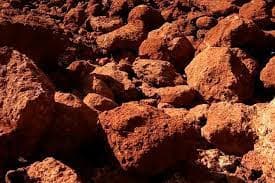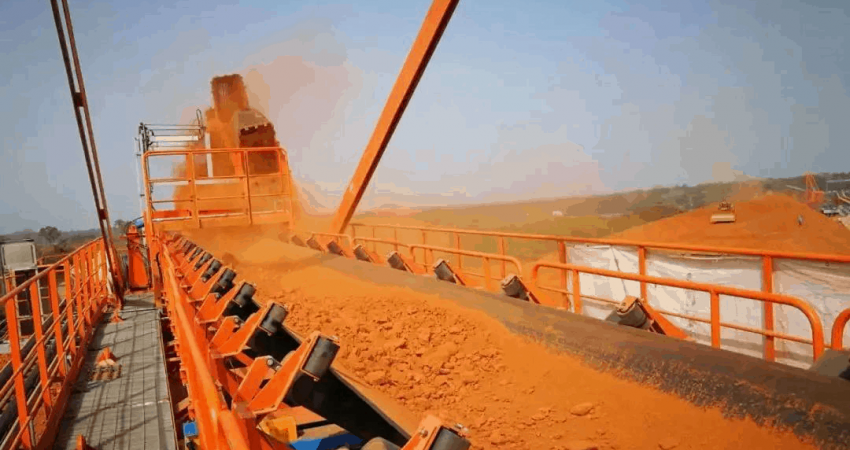The world is rich in bauxite resources. Bauxite is the best raw material for the production of metal aluminum, and its consumption accounts for more than 90% of the world’s total output. Bauxite is used in chemical industry, metallurgy, ceramics, refractory materials, abrasives, adsorbents, light industry, building materials, military industry, etc. In recent years, bauxite is the source of the development of the industrial chain, has a wide range of uses in the industrial field, and has a huge demand.

Bauxite, also known as bauxite, is generally a finely dispersed colloidal mixture composed of three minerals, diaspore, boehmite and gibbsite, in various proportions. Bauxite is often symbiotic with iron oxides and hydroxides, anatase and clay minerals such as kaolinite and chlorite. Bauxite ore can be divided into three categories: high-alkali bauxite, high-titanium bauxite, and high-iron bauxite according to the impurities it contains.
Bauxite ore Beneficiation Method
The main beneficiation methods of bauxite are washing, flotation, magnetic separation, chemical beneficiation, etc. The process of separating concentrates from bauxite ore is actually a process of removing gangue minerals and harmful impurities, and separating high-aluminum minerals and low-aluminum minerals to obtain concentrates with a high aluminum-silicon ratio. Bauxite beneficiation can not only utilize low-grade bauxite, but also play the role of grading, homogenizing, reducing impurities, and improving the refractory performance of refractory materials.
1. Ore washing is the simplest and most effective method to improve the aluminum-silicon ratio of bauxite. By washing the ore, the aluminum-silicon ratio of the ore can be increased by about 2 times, which is more effective for the sorting of loose ores. Ore washing is often combined with other sorting methods to form a ore washing (screening and washing)-classification-hand selection process.
2. Flotation separation can be used to separate diaspore and kaolinite, using oxidized paraffin soap and tar oil as collectors in alkaline medium. The bauxite flotation concentrate grade contains 49.65% alumina, and the recovery rate is 45.3%. For the desiliconization process of high-silica bauxite, flotation is more effective. The collectors of aluminum minerals include fatty acids and sulfonates, and the adjusters include sodium hexametaphosphate, tannin, sodium pyrophosphate, soda, Sodium carbonate.
Flotation beneficiation is a common method in various beneficiation processes. It is mainly used to separate diaspore and kaolinite, and alkaline substances are added to the flotation machine as a medium. So what are the factors that affect the flotation of bauxite?
(1) Flotation time. When the pulp is thick, the flotation time will be extended, which is beneficial to improve the recovery rate or increase the production capacity of the flotation machine.
(2) Recovery rate. When the pulp is very thin, the recovery rate is low, the concentration gradually increases, the recovery rate also increases gradually, and reaches the maximum value, and the recovery rate decreases after exceeding the optimum pulp concentration.
(3) Dosage of drugs. A certain concentration of chemicals must be maintained in the pulp to obtain good flotation results. When the pulp is thicker, the concentration of the liquid phase of the agent increases, and the dosage of the ore per ton of ore can be reduced, and vice versa.
(4) Water and electricity consumption. The thicker the pulp, the smaller the hydropower consumption to process a ton of ore.
(5) Concentrate quality. When the pulp is thin, the concentrate quality is higher; when the pulp is thick, the quality decreases.
(6) The production capacity of the flotation machine. As the concentration increases, the production capacity of the flotation machine can be increased.
3. Magnetic separation is used to separate iron-bearing minerals. The magnetic separator is mainly used to separate iron impurities in aluminum ore. When there are many impurities, iron impurities can be used as the main raw material for other purposes, thereby increasing the reporting investment ratio.
4. Chemical beneficiation method is mainly based on the hydrous aluminoband silicates in the minerals. As a result, part of the silica can be converted into tailings that have an amorphous shape and are easily dissolved into alkaline silica particles, thereby achieving the purpose of increasing the ratio of aluminum to silicon.

Generally speaking, the main beneficiation process of bauxite will use different beneficiation processes according to different types of ore:
(1) The beneficiation process of gibbsite-kaolinite bauxite. Usually, mud and sand are separated first, then magnetic separation is used to remove iron after coarse-grade grinding, and flotation is used after grinding of mud.
(2) The process of beneficiation of boehmite-oolitic bauxite. The characteristics of the original ore are that the fine-grained hematite and oolitic chlorite are closely combined with boehmite, and the ore is fragile. After the beneficiation is screened and washed, the coarse grade is selectively crushed and then classified, and the coarse grade is a product with a low aluminum-silicon ratio. Selective flocculation at the fine level can remove impurity iron.
(3) High silicon bauxite desiliconization beneficiation process. The flotation method is more effective. The aluminum mineral collectors include fatty acids and sulfonates, and the regulators include sodium hexametaphosphate, tannin, sodium pyrophosphate, soda, and sodium carbonate.
(4) High-speed iron bauxite beneficiation process. According to the content, type and embedded characteristics of iron minerals, different iron removal methods are adopted. Common ones are magnetic separation, roasting magnetic separation, and carrier flotation to remove iron.
The bauxite beneficiation process is complex, the operation is difficult, and there are many influencing factors. Therefore, various factors should be comprehensively analyzed and considered in actual production. In fact, flotation is the most commonly used method in bauxite beneficiation, but it is another matter for the associated organisms in some bauxite that are not suitable for flotation. At present, a large amount of beneficiation tailings and red mud produced from alumina production are directly stacked as wastes in the bauxite mining industry, resulting in a serious waste of resources. At the same time, the resource utilization of bauxite tailings treatment should be strengthened. Therefore, when choosing a bauxite beneficiation process, it should be determined according to the characteristics of the ore.